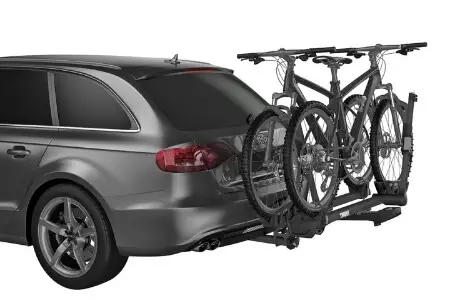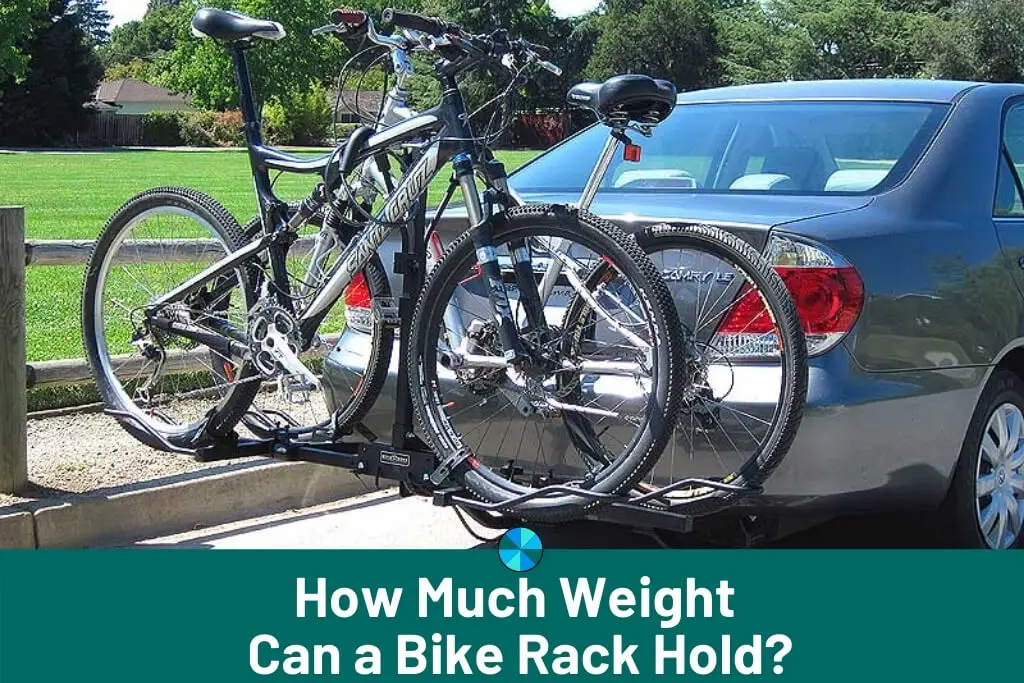People ask, how much weight can a bike rack hold?
Whether you are planning your first cycling holiday, or you have just bought a new bike, now you just need to find the right bike rack for your car or your RV.
You have spent a lot of money on your new bike and you want to ensure that it arrives safely at your destination.
How much weight can a bike rack hold? The average weight that a bike rack can hold varies between 17kg to 85kg (37 lbs to 188 lbs) depending on the model and type. Depending on the bike mix (racing bikes, mountain bikes, downhill bikes, cruisers) you can take between 3 and 6 bikes with you. The average bike weight would vary between 9 kg and 18 kg (20 lbs to 40 lbs).
There is a range of different styles of bike racks, some attach to the boot of your car, others to the roof or hitch.
There are also bike racks designed to fit vans or larger vehicles, depending on your individual requirements.
What are the key considerations for selecting the best bike rack material based on durability, installation ease, fit, weather resistance, and safety aspects?
When selecting the best bike rack material, it is crucial to consider several key factors to ensure durability, ease of installation, compatibility with your car, resistance to weather conditions, safety for both bikes and users, and overall functionality. Firstly, the material’s durability is essential to ensure that the bike rack can withstand regular use and last for a long time.
An easy-to-install bike rack material saves time and effort during setup, making it a more convenient option. Furthermore, the bike rack material should be compatible with your specific car model to ensure a secure fit. Weather resistance is another crucial aspect to consider as it can determine the material’s ability to withstand different weather conditions without deteriorating.
Safety features should also be taken into account, such as the material’s ability to prevent bikes from slipping, its overall sturdiness to support the necessary weight, and its safety for both children and pets who may come into contact with it.
Considering these key factors will help you select the best bike rack material that meets your needs in terms of durability, ease of installation, fit, weather resistance, and safety aspects.
Which material is considered the best for bike racks for cars according to the passage?
The best material recommended for bike racks for cars is steel. This material is praised for its optimal combination of qualities, including being reasonably weighted, safe, durable, and cost-effective.
Additionally, steel is highlighted as the most widely used material in the industry for bike racks.
What factors should be considered when buying a bike rack for a car in terms of materials?
We examined the advantages and disadvantages of each of the Bike Carriers for Car materials. In a few words, Aluminum is lighter than steel, so it’s a popular choice. Steel is also lightweight, but it tends to rust. Plastic can be clear or colored but although it’s heavy, it is virtually unbreakable.
What Material is Best for Bike Racks for Cars? The answer is: Steel is the best, which is fairly weighted, safer for the job, durable, and affordable in price. It is also the most popular material used in this industry. In other words, you can find far more bike racks that are made from this material.”
This article highlights the key considerations when choosing a material for a bike rack for a car, emphasizing the advantages and disadvantages of aluminum, steel, and plastic materials.
How can you determine the size of the bike rack needed for your car?
Why is it important to consider the size of the bike when choosing a bike rack for a car?
Considering the size of the bike is crucial when choosing a bike rack for a car because it directly affects the rack’s compatibility and functionality.
Selecting a rack that aligns with the size of the bike ensures a secure fit and safe transportation of the bikes to their destination.
What are the characteristics of basic, intermediate, and larger bikes in relation to choosing a bike rack?
Basic bikes with 16-inch wheels or smaller are foldable and can be transported on most cars. Intermediate bikes with 17-inch wheels and smaller can also be folded onto a bike rack.
Larger bikes, typically 18 inches and bigger, are not foldable and require specific racks designed to accommodate their size.
How can the size of the bike determine the type of bike rack needed for secure transportation?
The size of the bike directly impacts the type of bike rack needed for secure transportation. Smaller bikes that can be folded may require a different type of rack compared to larger bikes that are not foldable.
Choosing the appropriate rack size based on the bike’s dimensions ensures safe and secure transportation.
What are the rules to follow when selecting a bike rack based on the size of the bike?
The most important factor when choosing a bike rack is the size of the bike. It is crucial to select a rack that can securely hold all your bikes. The size of the bike will determine whether it can be folded for transportation or if it requires a larger, non-foldable rack.
What are the different sizes of bikes and how do they impact the choice of a bike rack?
Bikes with 16-inch wheels or smaller are considered basic bikes and can usually be folded and transported on the back of most cars.
Bikes with 17-inch wheels and smaller are intermediate bikes that can also be folded onto a bike rack. Bikes that are 18 inches and bigger are larger bikes that are typically not foldable.
Are hanging bike racks bad for your bike?
Hanging bike racks can potentially cause damage to your bike if not used and maintained properly. The main concern is the potential for damage to the finish of your bike, especially on matte black surfaces.
The metal components on the rack can chip off the paint if they constantly come into contact with the bike. Additionally, some bikes may not be suitable for hanging racks if they lack designated hooks on the wheels or frame, potentially leading to damage during attachment. Overall, hanging bike racks can be safe for your bike if used correctly.
It is essential to ensure the rack is kept in a covered environment to protect it from weather elements such as rain, snow, or direct sunlight. Regular maintenance and ensuring that the rack is securely attached without causing strain on the bike’s components are crucial in preventing any damage.
Using a bike cover while hanging it can also provide additional protection. To summarize, while hanging bike racks can be safe when utilized appropriately, there is a risk of damage if proper care is not taken.
Are there better alternative bike racks?
Various better alternatives for bike racks exist, each catering to different situations and locations. While there is no one-size-fits-all solution, individuals can choose from a range of options to suit their specific needs. One alternative is to utilize free bike parking at schools or universities nearby.
Checking if they have space and are willing to accommodate additional bikes can be a convenient and cost-effective solution. Another option is to secure a space in an old-fashioned garage with ample room for bike storage. Bikes can be attached to walls or placed upright to optimize space utilization.
For those preferring DIY solutions, installing hooks on garage ceilings or attaching wooden boards to walls can create a customized bike storage setup. This method is adaptable for both indoor and outdoor locations. Alternatively, investing in a wall-mounted bicycle stand can be a practical choice, particularly for garages or basements with available wall space.
Although this option may come with a higher price tag, it offers a sturdy and secure storage solution for those willing to make the investment.
Bike Rack Types
There are various types of bike racks depending on your individual needs such as boot bike racks, hitch bike racks and hitch bike racks.
Each can hold a varying amount of weight of between 17kg (37 lbs) and 85kg (188 lbs). Consider the type of vehicle you own, how many bikes you are hoping to carry, and the total weight of your bikes when deciding on the right rack for you.
Boot Bike Racks
Boot bike racks attach simply to the boot of your car and can usually carry between one and three adult-sized bikes. They are lightweight and compact, making them a good option for family bike rides in the park at the weekend.
The rack style is easy to load and unload while ensuring your bikes stay safe on the way to your cycling destination.
If you do not already have a roof rack or tow bar installed on your vehicle, this could be the best choice for you, especially if you aren’t a serious cyclist or you have limited storage at home.
The average boot bike rack can transport 2 to 3 bikes and carry a maximum weight of between 30 (66 lbs) to 45 kg (99 lbs).
Below is a list of some of the best boot bike racks and the maximum weight that they hold:
| Best Boot Bike Racks | Number of Bikes | Maximum Weight |
|---|---|---|
| Thule RaceWay 3 992 | 3 Bikes | 45kg (99 lbs) |
| Thule FreeWay 3 | 3 Bikes | 45kg (99 lbs) |
| Thule Raceway Platform Pro | 2 Bikes | 30kg (66 lbs) |
| Saris Bones EX 3-Bike Bike Rack | 3 Bikes | 45kg (99 lbs) |
| Exodus Rear High Mount 3-Bike Bike Rack | 3 Bikes | 45kg (99 lbs) |
Hitch Bike Racks
Hitch bike racks are a more sturdy and durable option, perfect for serious cyclists. This type of bike rack can be installed on most vehicle, however, it is important to check this with a bike rack specialist before purchase.
Hitch racks can usually carry up to four bikes and they are simple to load and unload. Hitch racks are connected to your vehicle’s tow bar.

They are a popular choice, especially if your car already has a tow bar.
The average hitch bike rack carries between 2 to 4 bikes and can hold a maximum weight of 30-60kg.
Below is a list of some of the best hitch bike racks and the maximum weight that they can carry.
| Best Hitch Bike Racks | Number of Bikes | Maximum Weight |
|---|---|---|
| Pendle Wheel Support 4 Bike | 4 Bikes | 60kg (132 lbs) |
| Thule Euro Classic G6 LED 929 | 3 Bikes | 60kg (132 lbs) |
| Halfords Four Bike TowBar-Mounted Rack | 4 Bikes | 60kg (132 lbs) |
| Thule Xpress Pro 970 Towbar-mounted Bike Rack | 2 Bikes | 30kg (66 lbs) |
| Thule VeloCompact 927 Towbar Rack | 3 Bikes | 60kg (132 lbs) |
Roof Bike Racks
Roof racks are one of the most versatile options for carrying bikes and other outdoor equipment. They usually allow customization to fit your snowboard, paddleboard as well as your bikes.
They are not only extremely versatile, but they are conveniently positioned and do not restrict access to the boot or car doors.
However, they are often slightly more expensive, and they do require lifting your bikes and equipment.
If you already have a roof rack installed on your vehicle, adapting it to a bike rack will be simple. Roof racks can fit most bike wheel sizes and can carry bikes without it being necessary to take off the wheels.
The average roof bike rack carries 1 bike and holds a maximum weight of between 17 and 20kg.
Below is a list of some of the best roof bike racks and the maximum weight that they can transport:
| Best Roof Bike Racks | Number of Bikes | Maximum Weight |
|---|---|---|
| Thule ProRide 598 | 1 Bike | 20kg (44 lbs) |
| Thule Outride 561 Roof Fork-Mounted Bike Rack | 1 Bike | 17kg (37 lbs) |
| SeaSucker Talon | 1 Bike | 20kg (44 lbs) |
| Yakima Highroad | 1 Bike | 20kg (44 lbs) |
| Thule ProRide 591 Roof Mounted Bike Rack | 1 Bike | 20kg (44 lbs) |
Other Considerations
Once you have decided on the right location for your bike rack, there are a number of other things to consider before you purchase one.
If you are a serious cyclist, it may be important to you that there is minimal contact between your bike and the mount. Thus, it is a good idea to take this into consideration.
Many bike racks hold the bikes by the wheels, rather than the frame, minimizing contact. If your bike is made of carbon, it is recommended that you consider a rack that transports the bike by its wheels to minimize the risk of damage.
The bike’s wheels are one of its most durable parts, meaning that there is no need to worry about carrying a bike by its wheels.
Bike Rack Installation: Halfords Rear High Mount Cycle Carrier >> Check Out the video below:
If you are embarking on a cycling holiday or a weekend cycle into the countryside with your family, it is likely that you will need easy access to your car boot.
If this is the case, choose a bike rack that allows easy access to your tent and supplies or picnic that is in the boot. If this is important to you, a boot rack may not be the right option.
Bike Weight Classes
There are two main bike rack weight classes, depending on your needs. The first rack class, often hanging rack models, can usually carry up to 40 pounds in weight.
while the second class can carry bikes weighing up to sixty pounds. It is also important to consider how easy it is to lift and manoeuvre your individual bike above your head if you are choosing a hanging rack style.
If you have difficulty with this, a rack that is easier to load, such as a platform model, may be more suitable.
Most normal road bikes weigh under thirty to thirty-five pounds, whereas heavier mountain bikes or electric bikes usually weigh under sixty pounds.
Bike Styles
If you are a mountain biker, you will need to take into consideration the wheel size and specifications of your bike. Whereas, if you own a “fatbike,” you will require a bike rack that holds bigger tires.
A family, with bikes of different sizes, will require a rack that accommodates this versatility and variation in size. Considering all of the bikes you wish to transport will ensure you pick the perfect bike rack to carry them all.
If you have an electric bike, make sure that the bike rack model you are considering is compatible with it.

Check that the rack is capable of carrying the extra weight of your electric bike, and that the bike’s form fits the carrier.
When transporting an electric bike, a tow bar bike rack is usually recommended because of its strength and stability. Tow-bar racks can usually carry the weight of two electric bikes.
Related reading: Are Touring Bikes Fast? (The TRUTH)
Take into consideration the maximum weight of your tow-bar that attaches to your car and ensure that the total weight of your bike-rack, as well as your bikes, are below that maximum weight.
If you load your tow-bar over the maximum limit, it could result in damage to your vehicle’s suspension as well as its steering.
Normal bike racks are designed for road bikes and not electric bikes; thus, it is necessary to ensure that your bike rack can withstand the weight of your electric bike.
Perhaps you have purchased a range of outdoor adventure toys and you are hoping to carry your bike as well as a paddleboard and ski equipment, make sure that you calculate the total weight to make sure your bike rack can withstand it.
It may even be a good idea to purchase a more versatile bike rack that can carry more weight than you currently need, especially if you are likely to buy more outdoor toys in the future.
Read also: Where Are Surly Bikes Made? What You Need To Know
To sum up
No matter whether you are looking to transport a mountain bike and snowboards on your car roof, or you are hoping to carry all of your family’s bikes on the back of your van, there is a bike rack perfect for you.
It is important to consider all of the options available to make sure that you choose the one that best suits your needs.
The average bike rack can carry between one and four bikes and a maximum weight of between 17kg and 60kg.
References
https://www.saris.com/support/getting-started-racks

